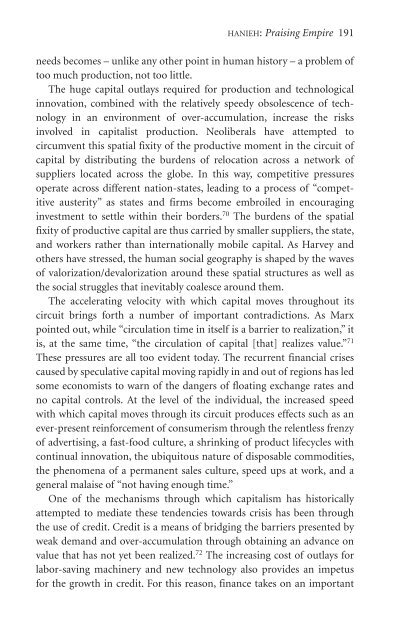New Imperialists : Ideologies of Empire
New Imperialists : Ideologies of Empire
New Imperialists : Ideologies of Empire
You also want an ePaper? Increase the reach of your titles
YUMPU automatically turns print PDFs into web optimized ePapers that Google loves.
HANIEH: Praising <strong>Empire</strong> 191<br />
needs becomes – unlike any other point in human history – a problem <strong>of</strong><br />
too much production, not too little.<br />
The huge capital outlays required for production and technological<br />
innovation, combined with the relatively speedy obsolescence <strong>of</strong> technology<br />
in an environment <strong>of</strong> over-accumulation, increase the risks<br />
involved in capitalist production. Neoliberals have attempted to<br />
circumvent this spatial fixity <strong>of</strong> the productive moment in the circuit <strong>of</strong><br />
capital by distributing the burdens <strong>of</strong> relocation across a network <strong>of</strong><br />
suppliers located across the globe. In this way, competitive pressures<br />
operate across different nation-states, leading to a process <strong>of</strong> “competitive<br />
austerity” as states and firms become embroiled in encouraging<br />
investment to settle within their borders. 70 The burdens <strong>of</strong> the spatial<br />
fixity <strong>of</strong> productive capital are thus carried by smaller suppliers, the state,<br />
and workers rather than internationally mobile capital. As Harvey and<br />
others have stressed, the human social geography is shaped by the waves<br />
<strong>of</strong> valorization/devalorization around these spatial structures as well as<br />
the social struggles that inevitably coalesce around them.<br />
The accelerating velocity with which capital moves throughout its<br />
circuit brings forth a number <strong>of</strong> important contradictions. As Marx<br />
pointed out, while “circulation time in itself is a barrier to realization,” it<br />
is, at the same time, “the circulation <strong>of</strong> capital [that] realizes value.” 71<br />
These pressures are all too evident today. The recurrent financial crises<br />
caused by speculative capital moving rapidly in and out <strong>of</strong> regions has led<br />
some economists to warn <strong>of</strong> the dangers <strong>of</strong> floating exchange rates and<br />
no capital controls. At the level <strong>of</strong> the individual, the increased speed<br />
with which capital moves through its circuit produces effects such as an<br />
ever-present reinforcement <strong>of</strong> consumerism through the relentless frenzy<br />
<strong>of</strong> advertising, a fast-food culture, a shrinking <strong>of</strong> product lifecycles with<br />
continual innovation, the ubiquitous nature <strong>of</strong> disposable commodities,<br />
the phenomena <strong>of</strong> a permanent sales culture, speed ups at work, and a<br />
general malaise <strong>of</strong> “not having enough time.”<br />
One <strong>of</strong> the mechanisms through which capitalism has historically<br />
attempted to mediate these tendencies towards crisis has been through<br />
the use <strong>of</strong> credit. Credit is a means <strong>of</strong> bridging the barriers presented by<br />
weak demand and over-accumulation through obtaining an advance on<br />
value that has not yet been realized. 72 The increasing cost <strong>of</strong> outlays for<br />
labor-saving machinery and new technology also provides an impetus<br />
for the growth in credit. For this reason, finance takes on an important


